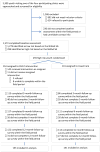Brief motivational interviewing intervention to reduce alcohol and marijuana use for at-risk adolescents in primary care
- PMID: 30138016
- PMCID: PMC6110093
- DOI: 10.1037/ccp0000332
Brief motivational interviewing intervention to reduce alcohol and marijuana use for at-risk adolescents in primary care
Abstract
Objective: The primary care (PC) setting provides a unique opportunity to address adolescent alcohol and other drug (AOD) use.
Method: We conducted a randomized controlled trial in 4 PC clinics from April 2013 to November 2015 to determine whether a 15-min brief motivational interviewing (MI) AOD intervention, delivered in PC, reduced alcohol and marijuana use and consequences. Adolescents ages 12-18 who came for an appointment during the 2.5-year study period were asked to be in the study and screened using the National Institute of Alcohol Abuse and Alcoholism Screening Guide. Those identified as at risk were randomized to the CHAT intervention or usual care (UC). Adolescents completed 4 web-based surveys at baseline and 3, 6, and 12 months postbaseline.
Results: The sample (n = 294) was 58% female and 66% Hispanic, 17% Black, 12% White, 5% multiethnic or other, with an average age of 16 years. Compared to UC adolescents, CHAT adolescents reported significantly less perceived peer use of alcohol and marijuana at 3 months (alcohol: p < .0001; marijuana p = .01) and 6 months (alcohol: p = .04; marijuana p = .04). CHAT adolescents also reported marginally fewer negative alcohol consequences experienced at 6 months (p = .08). At 12 months, compared to UC, CHAT adolescents reported less perceived peer alcohol (p = .04) and marijuana (p < .01) use and fewer negative consequences from alcohol (p = .03) and marijuana (p = .04) use.
Conclusions: A brief MI intervention delivered in PC reduced negative consequences from alcohol and marijuana use 1 year later. Findings emphasize that adolescents can benefit from PC interventions that briefly and effectively address both alcohol and marijuana use. (PsycINFO Database Record
Trial registration: ClinicalTrials.gov NCT01797835.
(c) 2018 APA, all rights reserved).
References
-
- Bandura A. Social learning theory. Englewood Cliffs, NJ: Prentice Hall; 1977.
-
- Bandura A. Self-efficacy: The exercise of control. New York, NY: Freeman; 1997.
-
- Berg Noora, Kiviruusu Olli, Karvonen Sakari, Kestilä Laura, Lintonen Tomi, Rahkonen Ossi, Huurre Taina. A 26-year follow-up study of heavy drinking trajectories from adolescence to mid-adulthood and adult disadvantage. Alcohol and Alcoholism. 2013;48(4):452–457. - PubMed
Publication types
MeSH terms
Associated data
Grants and funding
LinkOut - more resources
Full Text Sources
Other Literature Sources
Medical
Miscellaneous


